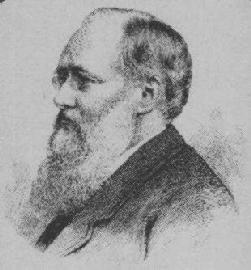(1824 - 1889)
William Wilkie Collins was born on 8th January 1824 in London, the son of a well-known Royal Academician landscape artist, William Collins. Named after his father, he swiftly became known by his second name (which honoured his godfather, David Wilkie). From the ages of 12-15 he lived with his parents in Italy, which made a great impression on him. At the age of 17 he left school and was apprenticed as a clerk to a firm of tea merchants, but after five unhappy years, during which he wrote his first novel, Iolani, he entered Lincoln's Inn to study law. After his father's death in 1847, Collins produced his first published book, Memoirs of the Life of William Collins, Esq., R.A. (1848), and also considered a career in painting, exhibiting a picture at the Royal Academy summer exhibition in 1849, but it was with the publication of his first published novel Antonina in 1850 that his career as a writer began. An instrumental event in Collins' career occurred in March of 1851 when he was introduced to Charles Dickens. They became lifelong friends and collaborators. Collins became an editor of Dickens' "Household Words", several of Collins' novels were serialized in Dickens' weekly publication, and Dickens later edited and published them himself. Collins suffered from a form of arthritis known as 'rheumatic gout' and became severely addicted to the opium that he took (in the form of laudanum) to relieve the pain. As a result he experienced paranoid delusions, the most notable being his conviction that he was constantly accompanied by a subjective doppelgänger he dubbed 'Ghost Wilkie'. His novel The Moonstone prominently features the effects of opium and opium addiction. While he was writing it, Collins' consumption of laudanum was such that he later claimed to have no memory of writing large parts of the novel. Collins never married, but lived, on and off from 1858, with a widow, Mrs. Caroline Graves, and her daughter, Elizabeth. He also fathered three children by another woman, whom he met after Mrs. Graves left him to marry Joseph Charles Clow on 29th October 1868. Mrs. Graves returned to Collins after two years, and he continued both relationships until his death. After Dickens's death in 1870, Collins remained a prolific writer, despite continued ill health. However, his addiction to laudanum had a negative impact on his productivity for the last two decades of his life. Collins, the inventor of "Make 'em cry, make 'em laugh, make 'em wait" books, died on 23 September 1889. He is buried in Kensal Green Cemetery in West London.
My selection:
The Woman In White : (La Dame En Blanc) 1860
The Woman in White, is a mystery narrated by draughtsman and artist Walter Hartwright and various other characters within the tale: most of whom are potentially questionable in what they say. It was published in 1860. The story begins with Walter's late night meeting of a woman dressed in white who he rescues from a group of pursuers. Walter goes to work in the service of the selfish and unpleasant Mr Fairlie as a drawing instructor and in doing so meets his niece Laura who strongly resembles the mysterious woman in white. Walter falls in love with Laura, but naturally there is a hitch. Laura does love Walter but is engaged to Sir Percival Glyde. Deceit, love and various unmaskings ensue that explain the strange confinement within an asylum of Anne Catherick. Tense adventures, villainy and gloriously fitting retributions are Collins's remedies.
The Moonstone : (La Pierre De Lune) 1911
This book is filled with superstition and the exotic. The Moonstone was published in 1868 and concerns the huge yellow diamond of the title that was once stolen from an Indian shrine. Rachel Verrinder receives the stone as a gift and does not realise that it has been passed to her in a sinister form of revenge by John Herncastle who, it transpires, acquired the moonstone by means of murder and theft. The jewel also brings bad luck. The stone disappears on the very night it is given to Rachel, though, and the tale concerns the unveiling of the culprit after the intervention of Sergeant Cuff, a famous London detective. A maid who is under suspicion commits suicide and Rachel herself seems reticent when it comes to aiding the investigation. Mysterious Indians appear frequently and there is an air of confusion and the unknown until the mystery is eventually solved.


